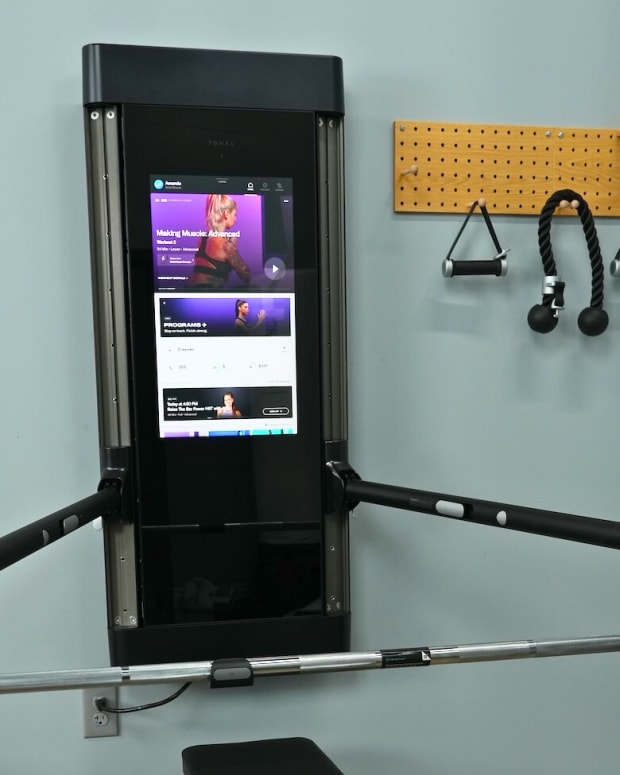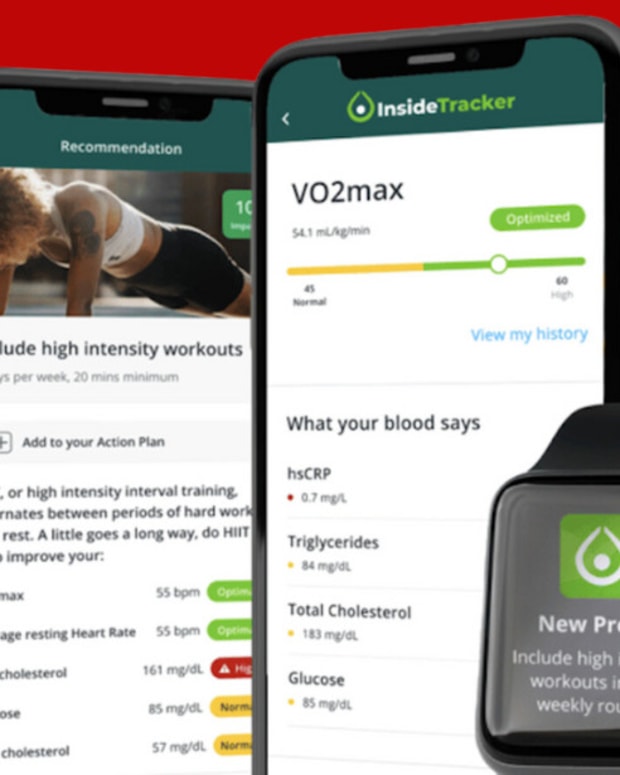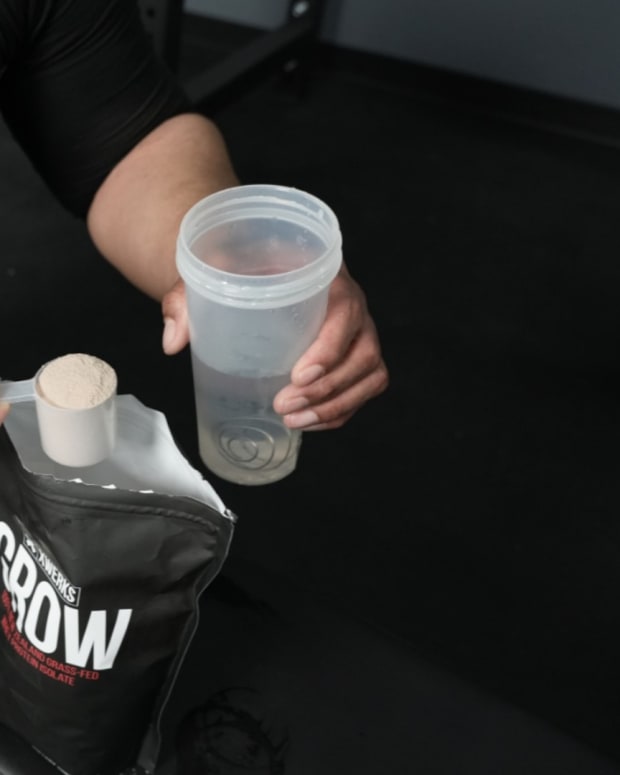The products featured in this article have been independently reviewed. When you buy something through the retail links on this page, we may earn a commission at no cost to you, the reader. Sports Illustrated editorial staff are not involved in the creation of this content. Learn more here.
The internet has revolutionized how we see experts, allowing “visits” to service providers like an online personal trainer from the comfort of home. Other health apps are rising in popularity, too, and it looks like the trend is only continuing to grow. The field of mental wellness—talk therapy in particular—has especially embraced the advent of telehealth. And online therapy platforms like Talkspace even transcend the “talking” part, allowing treatment to leap from the office and onto the page via text communication with the therapist.
I spoke to Gail Saltz, MD, an associate professor of psychiatry at New York-Presbyterian Hospital, Weill-Cornell School of Medicine. Saltz is also a practicing clinician who is well-versed on Talkspace: what the platform is; who the platform best serves; and why you may want to consider (or steer away from) a telehealth platform like Talkspace. I’ve highlighted the most important takeaways about Talkspace from my conversation with Saltz, and later walked through the sign-up process myself.
Mental health apps are not a substitute for a licensed professional. If you’re in crisis or having suicidal thoughts, text or call the Suicide and Crisis Help Line at 988.
This content is meant to be informative, but should not be taken as medical advice. It is not intended for use as diagnosis, prevention or treatment of health problems. Always speak with a professional care provider before starting any new wellness regimen.
What Is Talkspace?
Put in plain terms, Talkspace is teletherapy—remote therapy that uses some form of technology to connect the provider and client. The mode of treatment can range from leaving texts and audio messages up to live video sessions over the phone or a video chat app with the care provider. “Telehealth itself has been around a long time, preceding COVID-19, but the pandemic really ramped up the conversation around telehealth,” Saltz says.
She notes that the attitude toward teletherapy was somewhat ambivalent pre-pandemic. “Most people like me would have said, ‘Well, teletherapy is certainly better than nothing.’” However, the pandemic was highly instructive when it came to better understanding teletherapy, Saltz says. ”The data so far that has been made available shows that patients’ response to telemedicine can be just as good as in-person.”
Benefits of Talkspace
In fact, there may even be benefits to using the Talkspace platform over traditional in-office talk therapy. “You can be anywhere and talk to your therapist, as long as you have an internet connection and a phone. That makes the possibility of receiving care much more flexible,” Saltz says. Often, she points out, clients decide they can’t commit to therapy because of the logistics. The commute to an office and back, the block of time required for an appointment and the times the provider has available to schedule clients can all act as roadblocks that discourage people from attending regular appointments.
However, Talkspace eliminates those deterrents toward getting care. That’s especially true considering Talkspace’s most popular format: “The thing about Talkspace is that many people are using it predominantly in the text format—which could be good. That has some advantages for some people.”
Who Is Talkspace Best for?
Studies have shown that phone-anxious people prefer texting, making Talkspace an excellent option. Saltz says the younger demographic is most comfortable with the medium. “I think Talkspace is particularly appealing, frankly, to a younger population who’s really comfortable with texting as a form of communication. I can tell you that older people are probably not as much of a makeup of Talkspace.”
The texting element may be a big reason colleges gravitated toward Talkspace when institutions found themselves in the throes of a growing mental health crisis among young people, Saltz says. “We know that for young people levels of anxiety disorders and mood disorders are on the way up,” she says. Numerous studies back Saltz’s observation. Here’s statistics from a few:
- According to the 2021 Healthy Minds Study, a little less than half (47 percent) of university students reported a mental disorder diagnosis. Depression was the most commonly cited (44 percent), with 23 percent citing major depression. Another 37 percent cited a clinical anxiety disorder diagnosis.
- In the same study, 28 percent reported participating in self-harm activities in the past year, and 29 percent reported taking psychiatric medication during the same time.
- Finally, the study revealed that 1 in 7 college students reported suicidal ideation, an increase from the year prior.
Therefore it’s no surprise that colleges facing a mental health care crisis turned to Talkspace. “Mental healthcare at colleges has been totally overwhelmed in the last five, even 10 years, I would say. Many more students need care than they can afford and have faculty for on campus,” Saltz says. “And so some colleges have started basically saying, ‘We're going to pick up Talkspace for you students and pay for it,’ and they'll pay for the basic plan.”
That means paying for the text messaging plan, which Saltz reiterates isn’t necessarily a drawback. “There can be another advantage with text in that young people would rather think about, and then write down their thoughts, and be able to do it whenever they want to ‘Get it out’ in the moment. And Talkspace does afford you that.”
You can think of it this way: Traditional therapy typically means contact with a care provider is limited to once a week, barring an emergency. Talkspace, on the other hand, allows you to keep texting. “Now, your therapist isn’t going to answer every one of your texts right away,” Saltz says. But at some point—probably within 24 hours, depending on the therapist’s availability as stated within the app—you will get a response.
“Meanwhile, you have this capacity if you're thinking about something, you need to work something out, you're disturbed about something, you have questions—you can just text,” Saltz adds. “And I think for the college-age population that is really appealing.”
Who May Not Be Good Candidates for Talkspace
There are scenarios and populations where Saltz says she would not recommend Talkspace as a resource. “I would note that Talkspace is not good for an emergency,” she says. Talkspace, quick as it is, is not equipped to address an immediate crisis. “You're not going to sign up and someone will talk to you within an hour. It's probably going to be closer to 48 hours,” she says. For many situations, 48 hours is a good turnaround time. However, a crisis situation calls for contacting a 24-hour hotline service or an emergency room visit.
Saltz adds that Talkspace is better for psychiatric illnesses that are not considered to be extreme in severity. Talkspace is instead better equipped to address issues like mild to moderate depression; mild to moderate anxiety; family conflict; LGBTQIA issues; grief; difficulty sleeping; managing stress and managing anger, Saltz says. “However, for a serious psychiatric illness, I would not choose a texting service,” she says.
Who Are the Care Providers on Talkspace?
I wondered about Talkspace’s quality control, particularly since many providers tout their expertise within specific fields: “Everybody on Talkspace has to meet the standards of their claimed specialty: the training for the psychiatrist, or the training for the psychologist or the training for the social worker. They make sure those standards are met,” Saltz says.
Saltz notes that Talkspace also looks at feedback from people who have used its therapists. And Saltz says that depending on your locale it can be hard to find better qualifications with an in-person therapist. “People can go in-person to see someone who says they treat this and this, but maybe they've had minimal training and minimal experience,” she says.
There are also ways in which Talkspace will try to match you with a therapist who has the right type of training and experience. “Talkspace will give you a questionnaire to give them some guidance on what kind of a person you're looking for: specialty, area you think your difficulty is in, the kind of treatment that you're looking for,” Saltz says.
More important perhaps, there’s no penalty if you decide you’d like to switch therapists. And based on my experience with the app (more on that below), I can note that switching providers is a quick and seamless process.
Using Talkspace: Cost, Insurance and Services Available
A vital question if you’re looking into a new talk therapy regime remains: How does the cost of Talkspace compare to in-office therapy? The answer: It depends. But you’re certainly likely to be paying less if you’re without insurance in a major metropolitan area, Saltz says, especially for psychiatry services, which Talkspace offers. “However, if you're in a more remote, or lower-cost area, I couldn't say for sure,” she adds.
Unlike the monthly cost for other Talkspace services, payment for Talkspace Psychiatry is paid per session. The out-of-pocket cost to be initially evaluated by a nurse practitioner or psychiatrist is $299. Follow-up sessions run at $175 per appointment.
“Talkspace will get you a psychiatrist who is licensed in your state, and can prescribe to you, and you have the option of the care provider calling your medication into a pharmacy, or even sending it to you,” Saltz says. Practitioners can prescribe all medications, with the exception of controlled substances.
Talkspace is also covered by a number of health insurance plans. The platform is not covered by Medicare or Medicaid, however. And while often in-person therapists provide a sliding scale of payment for patients who aren’t insured, Talkspace can’t offer a sliding scale for payment. Promotions are quite common though, Saltz notes.
Talkspace cost aside though, accessibility can be a huge hindrance to getting care in less urban areas: “In many remote areas, there's a dearth of psychiatrists, psychologists and social workers—any kind of mental health care. And the ability to see someone on Talkspace is a huge plus because otherwise you might see nobody,” Saltz says. That's especially true for adolescents, Saltz says, and Talkspace does have services for children ages 13 and over. Talkspace psychiatry services, however, are for 18 and over patients only.
Talkspace Confidentiality and Security
Patients are often nervous about confidentiality in any treatment setting, Saltz says. So that could be especially true with Talkspace, given that with the texting plan, you’re leaving a digital footprint of your treatment regimen. “People wonder, ‘Is there any way people can see what I've written?’” Saltz says.
Fortunately, you don’t have to fret: Talkspace’s tech is fully compliant with HIPAA’s strict privacy standards, and uses systems of authentication and encryption to ensure confidentiality isn’t compromised. Members who use the Talkspace app can add an additional layer of security in the form of a password to open the app.
My Experience Signing Up for Talkspace
After my conversation with Saltz, I dove deeper into the nitty gritty of how Talkspace works. Step one: Downloading the app from the Apple App Store (Android users can find the Talkspace app in the Google Play Store). You can also complete the signup process on the Talkspace website.
Upon opening the app, Talkspace asks that you select from among the four types of services furnished: Online individual therapy, couples therapy, teen therapy and psychiatry. I tapped “continue” on the online therapy option, where the app prompted me to either enter my insurance information for an estimate of coverage, opt to pay out of pocket or use employer-provided EAP benefits.
After entering my insurance information, Talkspace directed me to indicate why I sought care. Selections included broad options like “I”m feeling anxious or panicky” and more specific issues like “I’ve been having trouble sleeping” as well as a “something else” option for situations not indicated. Next, the app asked me to rate my sleeping habits and physical health on a scale, provide my gender identity, preference for gender in a care provider and state of residence.
Talkspace pricing tiers and payment process
The app furnished three plans and their pricing tiers at this point in the setup:
- A video chat and text messaging therapy plan ($99 a week)
- A text-only subscription plan ($69 a week)
- Video, text and workshops plan ($109 a week)
The app was also running a promo at the time that knocked $30 off all of the plans for the first four weeks.
I did have to enter my payment information before being matched with a care provider—which gave me a slight pause—although the app reassured me that I wouldn’t be charged until I was matched with a Talkspace therapist. I used Apple Pay for the “amount pending” before being tasked with creating my account with a phone, email and password. It was nice to see off the bat that Talkspace required a pretty robust password, and then authenticated my account with an email.
Matching With and Switching Talkspace Providers
I was a little surprised that being “matched” with a provider was more akin to being “assigned” a provider, since I was charged and then introduced to my designated therapist upon authenticating my email. Other newly online health services, such as Future Personal Training, have a slightly more autonomous process for selecting your coach (or provider). Being able to select among three options isn’t available unless you want to switch to a new therapist. To test the ease of that feature, I went ahead and switched providers, and sure enough, the process was seamless and near-instantaneous.
From there, I completed a brief assessment with about 20 questions, after which I wasn’t sure what to do next. Fortunately, a video titled “How do I start?” was there to answer that very question right away, appearing prominently on the screen. And I didn’t need to fret for long, anyhow: The therapist, a licensed clinical social worker (anecdotal evidence only, but LCSW looked like a super common type of licensure among the app's providers) reached out by text message within a few hours to introduce herself in our shared chat room, and included a few get to know me questions.
I’m admittedly still a tad skeptical of the texting-based over in-person therapy sessions model, but I’ll be curious to see how I feel after the first month.
Talkspace FAQs
Can you get a refund from Talkspace?
No, Talkspace is not able to fulfill refunds for its services. If you want to try Talkspace, you’ll have to pay for the first month in full.
Can you cancel Talkspace at any time?
Yes, you can cancel Talkspace at any time. However, you will be charged for the first month automatically, despite the pricing being broken down by the weekly cost.
Can Talkspace help with anxiety?
Yes, anxiety is one of the most common mental health conditions that people in the U.S. face, and mild to moderate anxiety is an issue Talkspace is equipped to address.
Does Talkspace deal with ADHD?
Yes, your Talkspace online therapy provider can help you mitigate the obstacles presented by ADHD and ADD with techniques like cognitive behavioral therapy (often shortened to “CBT”) and organizational skills coaching.
Can Talkspace diagnose me?
Talkspace makes clear in its Terms of Use that “The site is not intended for diagnosis.” In order to be sure you’re seeking the right type of treatment for the right diagnosis, you should partake in live therapy sessions first, preferably in-person, for proper evaluation and diagnosis. That way, you can be sure an online counseling service will address your diagnosed condition.
Can Talkspace prescribe medication?
Yes, Talkspace psychiatry service providers can prescribe medication and help with medication management, with the exception of controlled substances.
Is Talkspace HIPAA-compliant?
Yes, Talkspace is HIPAA-compliant, and all communication is private and encrypted.
Final Thoughts
Talkspace users can connect with a licensed therapist remarkably easy, far beyond what I could have imagined was possible since when I first saw a therapist by arranging an appointment weeks in advance through my college’s student health center. That’s good news, Saltz reiterates, considering the growing need for care. And it’s worth noting that demand in need isn’t necessarily because people are more disordered. There’s also less stigma. “I think the stigma around mental healthcare has also been decreasing, so people are more comfortable seeking mental health services—their peers are doing it, they understand that's fine to do. And that's great,” Saltz says. And while leaving an audio message with your most intimate thoughts for someone you’ve never met IRL may feel a little strange at first, there’s a constant reassurance that you’re dealing with utmost mental health professionals who are solely there for the purpose to help you.
Overall, I think Talkspace is a good service for a wide variety of people, and Talkspace users report satisfaction with the service: The mobile app store rating of the platform on Apple is a 4.8 out of 5 based on more than 20,000 reviews. Having said that, this type of therapy is certainly not for everyone, and those with severe mental health issues should invariably see in-person follow-up and attention, per the recommendation of experts like Saltz.
Prices are accurate and items in stock as of publish time.











